Your Christmas Dinner Provides Evidence of Dinosaurs Close Relation to Birds
The idea that certain dinosaurs such as Velociraptor, Caudipteryx and even Tyrannosaurus rex were quite closely related to modern birds is now accepted by most scientists. Many lay people believe that this theory is quite modern, the idea of dinosaurs being related to birds coming about due to the amazing discoveries of feathered dinosaurs in places such as the Liaoning province in China. However, this idea has been around for at least 140 years.
Thomas Huxley, the English scientist and supporter of Charles Darwin first proposed a special classification for dinosaurs and birds, grouping them together in their own Order called “Sauropsida” demonstrating their close relationship. He studied the anatomical links between birds and reptiles and listed a number of characteristics that are shared between certain dinosaurs and birds, thus demonstrating that they must be closely related. He published his work in 1867, making the theory about a link between dinosaurs and birds much older than most people think.
Christmas Dinner Linked to Dinosaurs and Birds
Christmas is an ideal time for young, budding palaeontologists to explore the links between dinosaurs and birds and you don’t need a Victorian anatomy collection to do this – just your Christmas dinner.
You can spot several features in your Christmas roast Turkey, Goose or Chicken that helps link these birds to the theropod dinosaurs (the lizard-hipped group of dinosaurs that scientists believe are the direct ancestors of birds).
Here is the Everything Dinosaur guide to dissecting your Christmas roast so that you can demonstrate the close anatomical relationship between dinosaurs and our modern feathered friends. All you need is a sharp knife (parents to assist here), and you can see for yourself some of the traits that link your Christmas dinner with the likes of a ferocious Velociraptor.
The Everything Dinosaur Christmas Dinner Autopsy
There are a number of features in a roast turkey/goose/chicken dinner that you can identify that links these birds with their Dinosauria ancestors, but today we shall focus on just two, the breast bone (flight muscles) and the wishbone (the furcula). Once the bird has been cooked and has been taken out of the oven to rest, with a bit of careful carving you can see these characteristics for yourself.
Anatomical Feature 1 – Breast Bone and Flight Muscles
Carefully peel back the skin of the bird away from the breast, a word of caution here, even if the bird has been resting out of the oven for a few minutes the meat under the skin will still be hot so take care. Once the skin has been removed you can see the white breast meat. This meat is attached to the breast bone or sternal plate. Birds and dinosaurs share a similar sternal plate. The large area of white meat on the breasts is actually a muscle called the major pectoralis. This is the muscle which powers the down stroke of a bird’s wing.
A Picture of the Major Pectoralis Muscle (on our Christmas dinner)
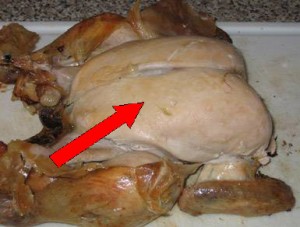
Picture credit: Everything Dinosaur
To visit Everything Dinosaur’s website: Visit Everything Dinosaur.
The red arrow is pointing to the major pectoralis muscle on the right-hand side of the bird.
Underneath this muscle is another major flight muscle called the supracoracoideus. This one is very easy to find in your Christmas roast, simply carefully remove the larger major pectoralis in strips and this will expose a long, lozenge shaped supracoracoideus muscle. This is the muscle that powers the upward movement of a bird’s wing in flight.
A Picture of the Supracoracoideus (on our Christmas dinner)
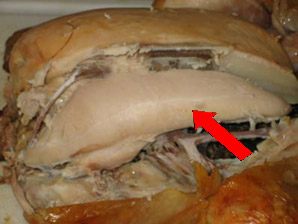
Picture credit: Everything Dinosaur
The red arrow is pointing to the supracoracoideus muscle, it is quite easy to recognise being a sort of tongue or lozenge shaped muscle directly under the white breast meat of the bird.
We therefore have identified the following muscles in our Christmas dinner:
- The major pectoralis – that powers the downward stroke of a wing beat.
- The supracoracoideus – which raises the wing.
We can trace the evolution of this muscle across theropod dinosaurs. These muscles sit on the breast bone (sternal plate) which is present in a variety of non-avian dinosaurs. Palaeontologists can study the fossilised muscle scars on the bones of dinosaurs, this is why we know that animals such as Velociraptor had these muscles present.
Tracing the Furcula – Anatomical Feature 2 (The Wishbone)
You can now remove these flight muscles to reveal the wishbone, take the wishbone out. The wishbone is formed by the fusion of two collarbones (the scientific name is clavicles); and is a feature present in both birds and dinosaurs. In birds it strengthens the skeleton to withstand the rigours of flight. The scientific name for the wishbone is the furcula.
The Wishbone from our Christmas Dinner
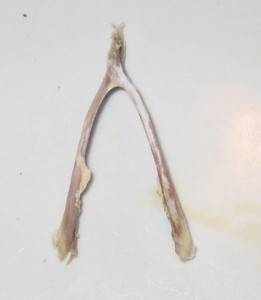
Picture credit: Everything Dinosaur
Wishbones have been associated with a number of excavated theropod fossils. It helps to demonstrate the link between dinosaurs and birds.
Oviraptor (first one found in the 1980s) – quite advanced more closely resembling the wishbones we find in birds. Other dinosaur wishbones discovered:
Velociraptor (another advanced wishbone design).
Bambiraptor, Albertosaurus, Gorgosaurus, Allosaurus and T. rex the biggest wishbone found to date (measures approximately 35 cm long and is shaped like a boomerang with a thick end and a slightly thinner end).
If the furcula is added to the skeleton of a theropod then the whole arrangement of the shoulder blades and the arm bones is called into question. Debate is ongoing whether the presence of a wishbone in certain dinosaurs would have altered palaeontologist’s interpretation as to the location of the shoulders and arms of these dinosaurs.
A Picture of an Albertosaurus without the Furcula
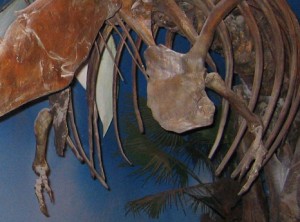
Picture credit: Everything Dinosaur
The above picture was taken by a member of the Everything Dinosaur team on one of their many visits to the Royal Tyrrell museum in Alberta, Canada. In an exhibit of Albertosaurus, an exhibit that had been mounted quite a few years ago, the forelimbs are shown to be spaced far about and no furcula has been added to this reconstruction.
A Picture of a Tyrannosaurus rex “Stan” with a Furcula
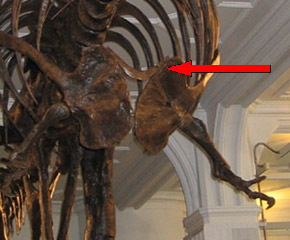
Picture credit: Everything Dinosaur
The picture above is a snap of the mounted cast of the “Stan” Tyrannosaurus rex.
The red arrow indicates where the wishbone or furcula has been reconstructed on top of the scapulae (the shoulder blades). This “U” or “V'” shaped bone has been found in a number of theropods, it may have been in contact with the anterior edges of the scapulae, coracoids and sterna (breastbone). Note how as a result of the addition of a furcula the position of the arms has been changed. The scapulae are positioned much closer together, which in turn positions the arms in closer proximity to each other.
Dinosaurs to Birds
There are other features of your Christmas dinner that we could use to illustrate the close anatomical relationship between birds and the theropod dinosaurs, the articulation of the hip-bone, the position of the legs under the body, the feet and such like, but we will save these for another time.
To view Everything Dinosaur’s huge range of dinosaur models including theropod dinosaur replicas: Dinosaur Models.
Meanwhile, the Christmas pudding is waiting and we think that we have dissected enough of our dinner, but there you have it – proof on your plate as to how closely related dinosaurs are to birds.
Merry Christmas.






Leave A Comment